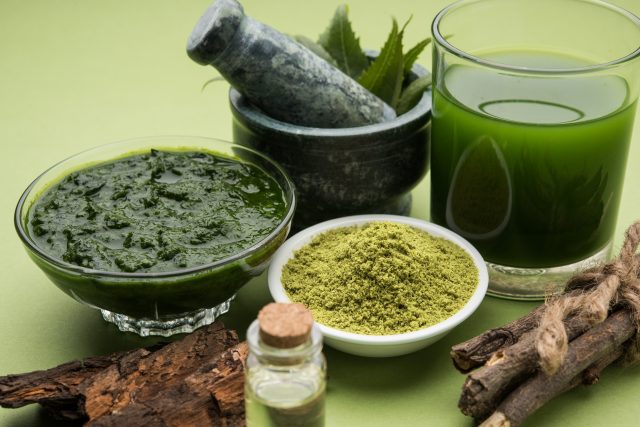The neem tree is called sarva roga nivarini (a cure for all diseases) in Ayurveda. It has amazing medicinal properties.
It is the season when the neem tree blossoms. Traditionally, we have learnt to recognize the signs and to benefit from nature’s own cycle and bounty. The neem blossom heralds the beginning of summer when all skin problems erupt due to the extreme heat. Before eradication, small pox epidemics would break out from April onwards. Even today, chicken pox and measles tend to spread, especially in children, during the summer. This is where the bitter neem and its products come into use.
The Neem’s botanical name is Azadirachta indica and it belongs to the mahogany family, Meliaceae. Also known as the Indian lilac and ‘Neemba’ (Sanskrit), neem contains over 130 different biologically active compounds. It is the ideal herb with anti-viral and anti-bacterial qualities.
Neem leaves were added to bath waters as they had antiseptic qualities. People with skin problems were laid upon beds of neem leaves to soothe their itchiness. Mothers who had delivered babies were protected by neem leaves placed at the entrance to their birthing rooms. The leaves are effective in neuromuscular pains. They purify the blood, remove toxins and are effective in insect bites and ulcers. The anti-bacterial properties heal infections, burns and other skin problems.
While the neem tree and its bark and leaves are bitter, its white delicate flowers have a sweet aroma and taste. The neem flowers are used fresh, dried or in a powdered form. They are an integral part of the New Year menu for Ugadi and Tamizh Varusha Pirappu. In Tamil Nadu, the first raw mango crop and fresh jaggery is made into ‘Ugadi Pachchadi’ and ‘Manga Pachadi’ with the addition of roasted neem flowers. The dish incorporates all the six tastes so that life in the coming year will be a mixture of good and bad, joy and sorrow, bitter and sweet in a balanced manner. Neem flowers can help in anorexia, nausea, belching and intestinal worms.
The twigs of the neem tree have traditionally been used to clean the teeth and gums. It keeps germs at bay, maintains alkaline levels in the saliva and polishes the enamel of the teeth. When you change twigs every day, oral hygiene is enhanced.
Traditional soaps have neem oil in them because of its medicinal properties. It is a great defoliant and is added to the lamp oil in pooja rooms to repel insects and mosquitoes. It is used in agriculture as well to keep fungus at bay.
How to use neem in your daily life
- Blend neem leaves into a paste and apply on wounds and insect bites. Neem poultices drain excess fluid and pus from wounds.
- Use it as an application on mouth ulcers, especially in oral cancer caused by chewing tobacco and betel leaves.
- Dandruff can be prevented by adding neem leaves to a pan of water and boiling it till the water becomes green. Cool and use the green water to rinse the scalp and hair after shampooing.
- For itchy, irritated and red eyes, add neem leaves to boiling water and let it seep in. Cool and wash the eyes with this liquid.
- Heat brings out skin rashes and pimples. Blend neem leaves and apply this paste on the face. Leave it to dry. Use daily till skin clears up.
- Neem paste can be used on any festering eruptions and dark spots—especially under the eye.
- Swallow a small ball of neem paste to heal mouth and stomach ulcers.
- Turmeric and neem paste masks act as healers for skin problems like eczema, allergies and ring worms.
- If you have chronic immunity problems, shred and smash a few neem leaves, add half a spoon of turmeric, salt and honey and swallow in a glass of water.













































